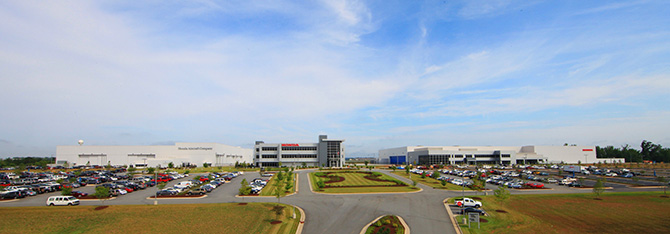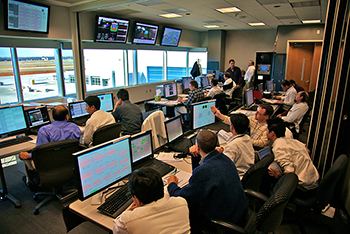HondaJet: Routes less traveled
The unusual HondaJet gains performance by skipping convention

October 2011
Turbine Pilot Contents
- Turbine Intro: Powering into the future: Special section for the turbine inclined.
- The NeXT Beechjet: New power, panel, and pylon mods for the “old” Beechjet
- Routes Less Traveled: HondaJet sprints toward 2012 certification schedule
- Flying the Jumbo, Jumbo: Taking on the A380
- Honeywell’s SmartView Moves Ahead: Merging infrared with synthetic vision
The first conforming production HondaJet (above) joined the flight test program in December 2010. The proof-of-concept (left) has been flying since December 2003, racking up some 500 flight hours on 400 missions. The natural laminar flow cockpit area and over-the-wing engine mounts distinguish the unusual design.
As the stunning blue and white HondaJet made its fly-bys at EAA AirVenture 2011, the comments among those watching seemed unanimous: “That’s quiet.”
“You can hardly hear it.” “That’s remarkably quiet.”
And these observers weren’t casual air show attendees. These were employees of a jet engine manufacturer—one competitive to the GE-Honda engines powering the unusual HondaJet.
Those overheard remarks as I happened to be standing next to the competitive engine manufacturer’s exhibit highlight the interest and mystery surrounding the first airplane built for certification purposes by the giant auto manufacturer.
The HondatJet project was kept under wraps for years, with word trickling out occasionally from the Greensboro, North Carolina, development center that the company was developing a light jet. Every once in a while someone would post a snapshot of the airplane taken through the fence as it launched for another test flight. Finally, in 2005, 18 months after the aircraft first flew, Honda invited AOPA Pilot to Greensboro to be the first publication introduced to the airplane.
In the resulting August 2005 cover story, HondaJet designer Michimasa Fujino explained the years-long process he endured designing the airplane and then convincing Honda to fund it. Even in 2005 there was no commitment from the company to certify and produce the business jet. Instead, the unveiling was part of a year-long study of market reaction to see whether certification should commence.

In 2006, the company gave the project the green light and the Honda Aircraft Company was formed with Fujino as its president and CEO. Construction on a world headquarters building began in Greensboro shortly thereafter. In July 2011, the company invited the public to see the facilities, which encompass some 500,000 square feet including offices, a research and development center, manufacturing plant, and a gleaming four-bay paint facility.
On a separate track, the partnership between General Electric and Honda continued development of the HF120 turbofan engines that will power the HondaJet and will be made available to other manufacturers. Honda Aero, manufacturer of the GE Honda line of engines, built its new headquarters in Burlington, North Carolina.
The blue and white proof-of-concept HondaJet first flew in December 2003, a few days before the one-hundredth anniversary of powered flight by the Wright brothers. Initially powered by HF 118 engines producing 1,670 pounds of thrust, the POC has flown some 500 hours on 400 missions. The FADEC-controlled production HF 120 engines will produce 1,880 lbst, shoving the airplane along at a maximum cruise of 420 KTAS and as high as 43,000 feet, 2,000 feet higher than originally projected.
Breaking with convention
 The HondaJet is unusual in several ways. It has a Fujino-designed natural laminar flow aluminum wing, a natural laminar flow composite cockpit section, and a constant-contour composite cabin section. The wing maintains laminar flow over 42 percent of the upper surface and, most unusually, a high 63 percent on the bottom of the wing.
The HondaJet is unusual in several ways. It has a Fujino-designed natural laminar flow aluminum wing, a natural laminar flow composite cockpit section, and a constant-contour composite cabin section. The wing maintains laminar flow over 42 percent of the upper surface and, most unusually, a high 63 percent on the bottom of the wing.
The constant–contour cabin is possible because of the unusual engine placement. Rather than hanging the engines off the empennage, which required substantial structural support and, as a result, reduced aft cabin space, Fujino spent years developing a method to place the engines on top of the wings inboard near the empennage.
The over-wing engine mount allows full use of the cabin area, giving the HondaJet a much larger and more flexible cabin configuration compared to similar-sized jets and reduces drag compared to airplanes with conventional tail-mounted engines.
 The efficiency of the design and the new generation engines allow the airplane to cruise some 10-percent faster with a 30-percent larger cabin and baggage area while burning 15- to 20-percent less fuel than conventional designs, according to Honda Aircraft. IFR range is projected at 1,180 nm. A takeoff distance of 3,120 feet and landing distance of 2,500 feet will allow operation from thousands of airports.
The efficiency of the design and the new generation engines allow the airplane to cruise some 10-percent faster with a 30-percent larger cabin and baggage area while burning 15- to 20-percent less fuel than conventional designs, according to Honda Aircraft. IFR range is projected at 1,180 nm. A takeoff distance of 3,120 feet and landing distance of 2,500 feet will allow operation from thousands of airports.
Hydraulics power the beefy trailing link landing gear system. The brakes are electrically actuated hydraulics and taxiing is by a steer-by-wire system. Conventional bleed air systems provide anti-ice on the wings; an electric impulse system clears the tail of ice.
Inside, Fujino and his design team have spent years observing and flying in competitive airplanes, attempting to find ways to differentiate the HondaJet’s five-seat cabin—beyond the greater interior space.
 Among the unusual features is a skylight in the aft lavatory—a much larger lav than would be expected in an airplane that overall is about the size of a Cessna CJ1+. The toilet is fully flushing and externally serviceable—unusually sophisticated in this class of airplane.
Among the unusual features is a skylight in the aft lavatory—a much larger lav than would be expected in an airplane that overall is about the size of a Cessna CJ1+. The toilet is fully flushing and externally serviceable—unusually sophisticated in this class of airplane.
In the HondaJet cabin mockup, with the touch of a button, hidden entertainment screens drop down from the ceiling above each of the four club cabin seats. Windows can be electrically dimmed. Folding armrests retract automatically into the sides of the seatbacks when not in use, maximizing aisle space.
Fujino declares that the company’s automotive heritage will help it provide a consistently high fit-and-finish to its interiors. The flight deck will be commanded through a Garmin G3000 cockpit suite, an upgrade from the G1000 in the POC. The G3000 features small touch-screen displays for entering data and interacting with the larger primary and multifunction displays. The airplane will be certified for single-pilot operations.
Just the beginning
 Fujino reminds that Honda is a $100 billion-plus company with 179,000 employees around the world.
Fujino reminds that Honda is a $100 billion-plus company with 179,000 employees around the world.
“We are a mobility company,” he said, producing everything from 45-mph motorcycles to 420-knot jets. Although the Model 420 HondaJet isn’t scheduled for certification and deliveries until the end of 2012, several years behind the original plan, Fujino is already thinking ahead.
“I would like to design and build one more airplane,” he told me. He and others at Honda Aircraft indicated that the Model 420 is only one in a family of airplanes planned by the company, although no more details about the future family members were provided. The constant-contour composite fuselage could seemingly be easily stretched.
The first production conforming airplane—painted gray—joined the flight test program in December 2010. The second flying conforming model was expected to join the process this fall and the third by the end of the year. When AOPA Pilot visited the factory in July 2011, the second conforming model was painted—red—and appeared to be close to completion. The third was just behind it in the company research and development center—on its landing gear and being fitted with systems. All in all, five conforming airplanes will be employed for the flight test program.
The company admits to some 100 orders for the airplane with a price of approximately $4.5 million. However, several staff members indicated the actual number is closer to 200 orders. The airplanes will be sold by a network of dealers, many of them affiliated with Piper Aircraft through an alliance announced in 2006. For more information, see the website.
Email the author at [email protected]; follow on Twitter: tomhaines29



